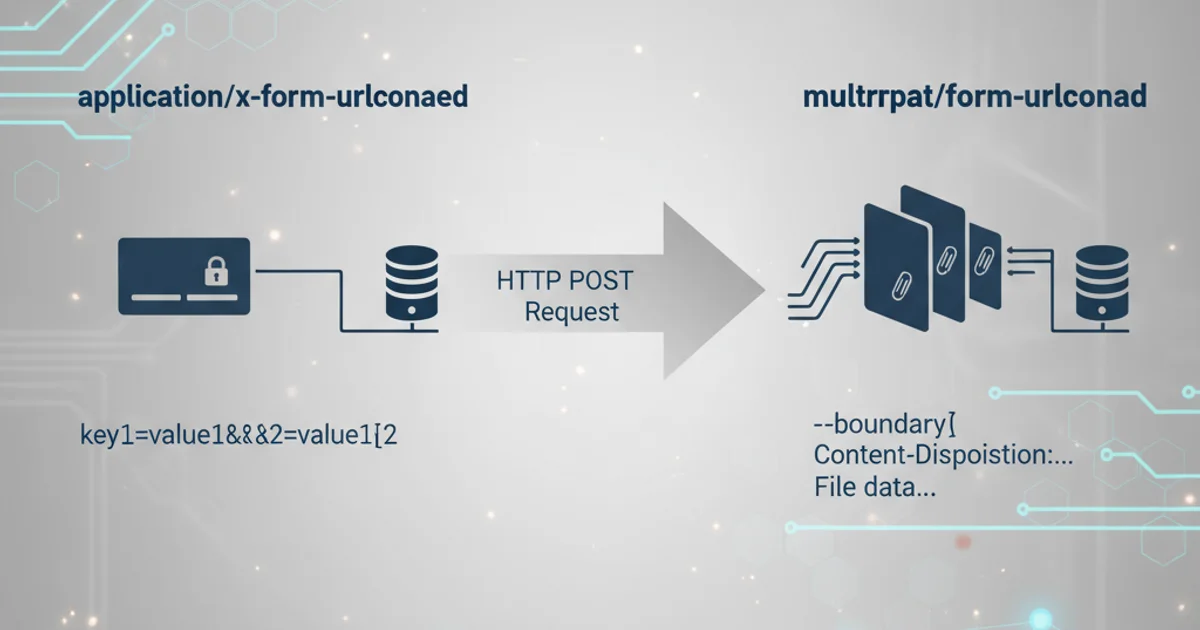application/x-www-form-urlencoded or multipart/form-data?
Categories:
application/x-www-form-urlencoded vs. multipart/form-data: Choosing the Right Content-Type

Understand the differences between application/x-www-form-urlencoded and multipart/form-data for HTTP POST requests and learn when to use each for optimal data transmission.
When sending data to a server via an HTTP POST request, one of the most crucial decisions is selecting the appropriate Content-Type header. This header informs the server about the format of the data being sent in the request body, allowing it to parse the information correctly. The two most common Content-Type values for form submissions are application/x-www-form-urlencoded and multipart/form-data. While both are used for sending form data, they serve different purposes and have distinct characteristics that make them suitable for specific scenarios. This article will delve into their technical differences, use cases, and best practices.
Understanding application/x-www-form-urlencoded
The application/x-www-form-urlencoded content type is the default for HTML forms when no enctype attribute is specified. It's designed for sending simple key-value pairs, similar to how query parameters are structured in a URL. When data is sent using this type, all form field names and values are URL-encoded before being concatenated into a single string. Spaces are replaced by + symbols, and special characters are replaced by their hexadecimal equivalents (e.g., %20 for a space). The entire string is then sent as the body of the HTTP request.
This method is efficient for small amounts of text data, but it has limitations, especially when dealing with binary data or large text blocks. Because all data is encoded into a single string, it's not well-suited for file uploads.
POST /submit-form HTTP/1.1
Host: example.com
Content-Type: application/x-www-form-urlencoded
Content-Length: 30
name=John+Doe&email=john%40example.com
Example HTTP request using application/x-www-form-urlencoded
application/x-www-form-urlencoded is the default for HTML forms. If you don't specify an enctype attribute on your <form> tag, this is what will be used.Understanding multipart/form-data
The multipart/form-data content type is specifically designed for sending larger amounts of data, particularly when dealing with file uploads or a mix of text and binary data. Unlike application/x-www-form-urlencoded, it does not encode the entire request body into a single string. Instead, it breaks the data into multiple parts, each representing a form field or a file. Each part has its own set of headers (like Content-Disposition and Content-Type) and its own body, separated by a unique boundary string.
This structure allows for efficient transmission of various data types, including binary files, without the need for extensive encoding that would bloat the request size. It's the standard choice for forms that include <input type="file"> elements.
POST /upload-file HTTP/1.1
Host: example.com
Content-Type: multipart/form-data; boundary=----WebKitFormBoundary7MA4YWxkTrZu0gW
Content-Length: 200
------WebKitFormBoundary7MA4YWxkTrZu0gW
Content-Disposition: form-data; name="username"
JaneDoe
------WebKitFormBoundary7MA4YWxkTrZu0gW
Content-Disposition: form-data; name="profile_picture"; filename="avatar.jpg"
Content-Type: image/jpeg
[Binary data of avatar.jpg]
------WebKitFormBoundary7MA4YWxkTrZu0gW--
Example HTTP request using multipart/form-data for file upload
flowchart TD
A[Client Sends POST Request] --> B{Content-Type Header?}
B -->|application/x-www-form-urlencoded| C[URL-encode all key-value pairs]
C --> D[Send as single string body]
D --> E{Server Parses URL-encoded string}
B -->|multipart/form-data| F[Divide data into parts with boundaries]
F --> G[Each part has headers and body]
G --> H[Send as multi-part body]
H --> I{Server Parses multi-part body}
E --> J[Process Data]
I --> JDecision flow for choosing Content-Type
When to Use Which
The choice between application/x-www-form-urlencoded and multipart/form-data largely depends on the nature of the data you are sending:
Use
application/x-www-form-urlencodedwhen:- You are sending simple, relatively small text-based key-value pairs.
- You are not uploading any files.
- The data can be easily represented as URL-encoded strings.
- It's the default behavior for many web frameworks and is simpler to handle for basic form submissions.
Use
multipart/form-datawhen:- You need to upload one or more files (e.g., images, documents).
- You are sending a mix of text fields and binary data.
- The form data includes large text blocks that might be inefficient to URL-encode.
- It's explicitly required by an API for file uploads.
application/x-www-form-urlencoded will typically result in errors or corrupted data, as the binary content will be incorrectly URL-encoded.Practical Considerations and Best Practices
While the choice often seems straightforward, here are some additional points to consider:
- Performance: For very small amounts of text data,
application/x-www-form-urlencodedmight have a slight edge due to simpler parsing. However, for anything involving files or larger data sets,multipart/form-datais more efficient as it avoids unnecessary encoding overhead. - Server-Side Parsing: Most modern web frameworks and server-side languages (e.g., Node.js with Express, Python with Flask/Django, PHP, Java with Spring) have built-in support for parsing both
Content-Types. Formultipart/form-data, libraries likemulter(Node.js),Werkzeug(Python), orApache Commons FileUpload(Java) are commonly used to handle file uploads. - Security: Neither
Content-Typeinherently provides more security than the other. Security considerations like input validation, sanitization, and using HTTPS are paramount regardless of the data encoding method. - API Design: When designing APIs, clearly document which
Content-Typeis expected for each endpoint, especially for those involving file uploads.